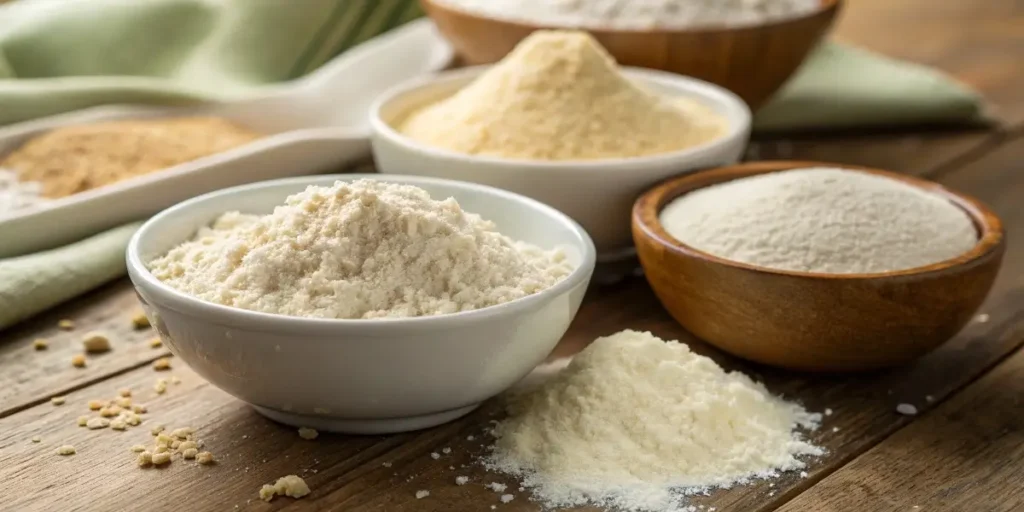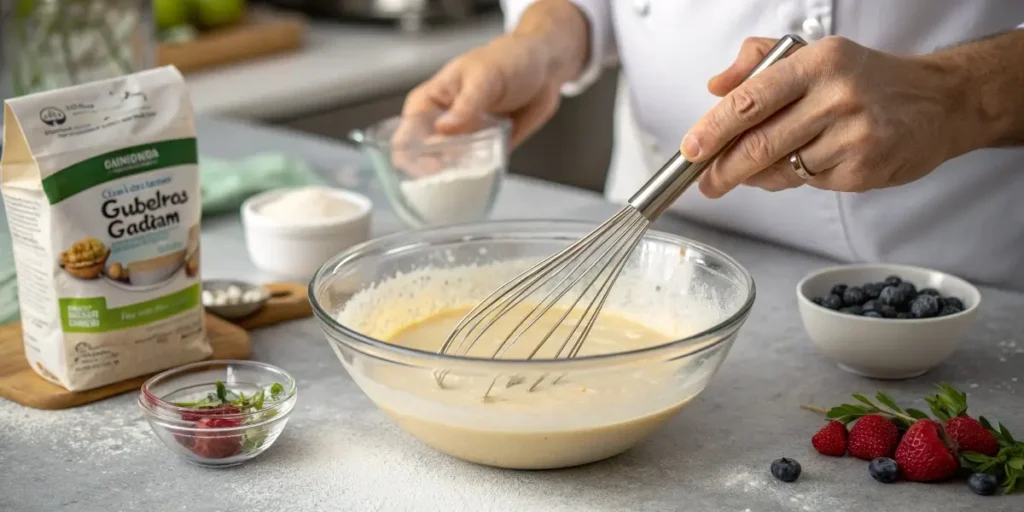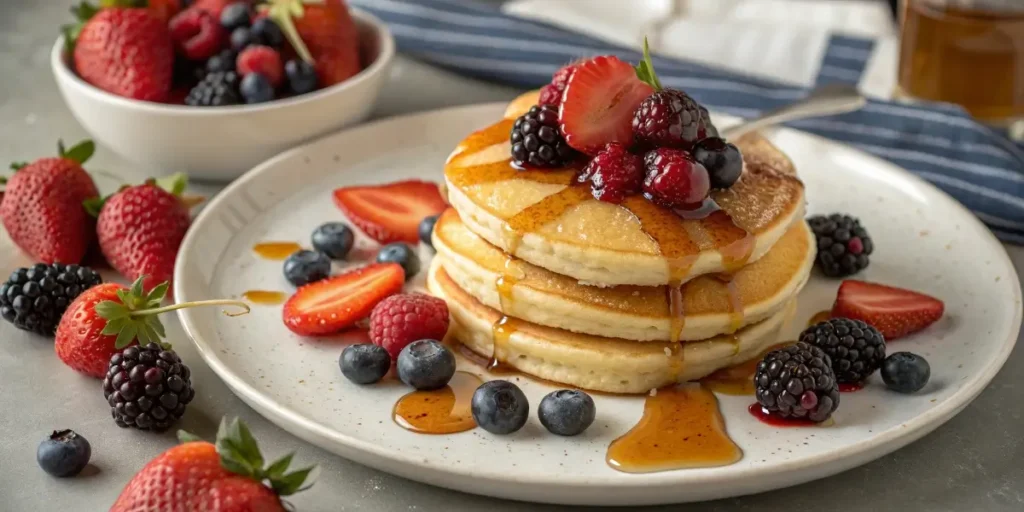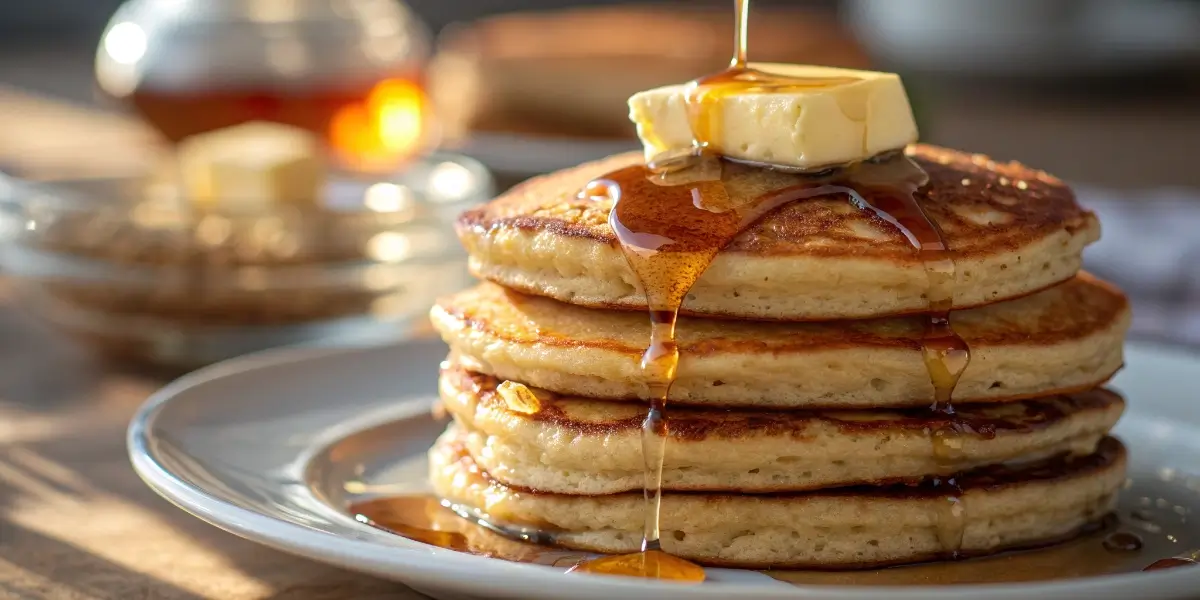Gluten Free Pancake Mix: The Ultimate Guide to Fluffy, Delicious Pancakes
If you’ve ever woken up craving a warm, stack of pancakes but needed a gluten-free option that doesn’t fall flat — you’re in the right place. In this complete guide to gluten free pancake mix, we’ll break down everything from the science behind gluten-free flours to the best ways to make your own mix at home. You’ll also learn what common mistakes to avoid and how to get that signature light, fluffy texture every time.
Whether you’re newly gluten-free or simply looking to improve your breakfast game, this article covers it all — ingredients, techniques, store-bought brands, and expert tips to perfect your batter. Plus, we’ll share how to make your own custom gluten-free mix so you can whip up pancakes anytime, without stress.
Don’t miss our fluffy-mini-pancakes recipe for a delicious breakfast twist that’s already gluten-free friendly.
Table of Contents
Understanding Gluten Free Pancake Mix
What Makes a Pancake Mix “Gluten Free”
A pancake mix becomes “gluten free” when it’s made without wheat, barley, or rye — grains that naturally contain gluten. Instead, gluten-free mixes rely on alternative flours like rice flour, almond flour, oat flour, or a blend of several gluten-free grains. These flours don’t have the elasticity gluten provides, so a proper mix must include ingredients that mimic that binding structure.
Typically, a quality gluten free pancake mix will include a balanced blend of starches (such as tapioca or potato starch) and stabilizers like xanthan gum or guar gum. These help the batter hold together and create the soft, fluffy texture you’d expect from traditional pancakes. The right ratio is key — too much starch can make the pancakes gummy, while too little can leave them crumbly.
Why People Choose Gluten Free Pancake Mix
People turn to gluten-free mixes for several reasons: dietary restrictions, celiac disease, gluten sensitivity, or personal preference. For those with celiac disease, avoiding gluten isn’t optional; it’s necessary to prevent serious health issues. Others may notice improved digestion or less bloating when they remove gluten from their diet.
Additionally, many families enjoy gluten free pancake mix simply for variety or to explore new ingredients. The best part? Modern gluten-free blends have evolved tremendously — they’re now capable of producing pancakes that are just as fluffy and golden as their gluten counterparts. With a few smart tweaks, you won’t even miss the wheat flour.
Ingredients That Make the Best Gluten Free Pancake Mix
Choosing the Right Gluten-Free Flour Blend
The secret to any good gluten free pancake mix starts with the flour. Since no single gluten-free flour can perfectly mimic wheat on its own, the best results come from using a balanced blend. Most high-quality mixes include a combination of rice flour, tapioca starch, and potato starch. Each plays a role: rice flour adds structure, tapioca gives elasticity, and potato starch creates tenderness.

For a homemade blend, use this ratio as a starting point:
| Ingredient | Purpose | Suggested Amount (per 1 cup mix) |
|---|---|---|
| White rice flour | Base structure | ½ cup |
| Tapioca starch | Light texture | ¼ cup |
| Potato starch | Soft crumb | ¼ cup |
To enhance the flavor and nutrition, try incorporating oat flour, almond flour, or sorghum flour. These flours add a mild sweetness and make the pancakes heartier. Just remember that balance is everything — too much nut flour can make the pancakes heavy.
Learn more about mixing your own flour blend with our detailed guide: pillsbury gluten-free flour
What Kind of Milk Works Best for Gluten Free Pancakes
Milk plays a crucial role in binding the dry ingredients and activating leavening agents like baking powder or baking soda. The type of milk you use can affect both texture and taste. Whole milk offers a rich, tender crumb, while buttermilk adds a slightly tangy flavor and makes pancakes extra fluffy.
If you’re avoiding dairy, don’t worry — unsweetened almond milk, oat milk, or soy milk work beautifully. Almond milk creates a light texture, oat milk adds creaminess, and soy milk provides body. The trick is to keep the batter thick but pourable; too thin, and the pancakes will spread too much.
No matter which milk you choose, always let the batter rest for 5–10 minutes before cooking. This allows the gluten-free flours to hydrate fully, leading to softer, more cohesive pancakes every time.
How to Make a Homemade Gluten Free Pancake Mix
Step-by-Step Recipe for a Basic Gluten Free Pancake Mix
Making your own gluten free pancake mix at home isn’t just economical—it gives you full control over the texture, flavor, and nutrition. Here’s a simple base recipe that you can easily customize:
| Ingredient | Measurement | Purpose |
|---|---|---|
| Rice flour | 2 cups | Light base structure |
| Tapioca starch | 1 cup | Adds elasticity and chew |
| Potato starch | ½ cup | Keeps pancakes tender |
| Baking powder | 2 tbsp | Lifts and fluffs the batter |
| Baking soda | 1 tsp | Balances acidity |
| Salt | ½ tsp | Enhances flavor |
| Sugar | 2 tbsp | Adds sweetness |
| Xanthan gum | 1 tsp | Acts as binder |
Instructions:
- In a large mixing bowl, whisk together all dry ingredients until evenly combined.
- Store the mixture in an airtight container at room temperature for up to 2 months.
- When ready to cook, combine 1 cup of the mix with ¾ cup milk (dairy or plant-based), 1 egg (or flaxseed substitute), and 2 tbsp melted butter or oil.
- Cook on a greased non-stick skillet over medium heat until golden brown on both sides.
This homemade blend rivals store-bought versions and costs a fraction of the price. Plus, it’s easily adaptable for vegan or dairy-free diets.
How to Store and Preserve Your Pancake Mix
To maintain freshness, store your gluten free pancake mix in an airtight jar or container, preferably in a cool, dark place. Moisture and humidity are the biggest enemies—too much exposure can cause the leavening agents to lose their power.
If you live in a humid climate, keep the mix in the refrigerator or freezer. It’ll last up to six months this way. For best results, label your container with the date and ingredients. When you’re ready to use it again, simply scoop, mix, and pour—no need to measure each time.
Discover more gluten-free cooking staples and ideas in our gluten-free-side-dishes collection for inspiration.
Common Mistakes to Avoid with Gluten Free Pancakes
Overmixing the Batter: Why It Matters
One of the most common errors when preparing a gluten free pancake mix is overmixing the batter. While regular wheat-based pancakes can handle a little extra stirring, gluten-free batters are more delicate. When you overmix, the starches from rice, tapioca, or potato flours break down, creating dense, gummy pancakes instead of light, fluffy stacks.
To avoid this, whisk the wet and dry ingredients just until combined. A few small lumps are perfectly fine—they’ll smooth out while cooking. The goal is to keep as much air in the batter as possible to achieve that pillow-like texture.
For an even better rise, let your batter rest for about 10 minutes before cooking. This step allows the starches to fully hydrate, resulting in softer, more cohesive pancakes that hold together beautifully on the griddle.
Heat Control: Preventing Dry or Gummy Pancakes
Another frequent mistake involves cooking temperature. Gluten-free pancakes mix brown faster than traditional ones because of the natural sugars in alternative flours. If the skillet is too hot, the outside will brown (or burn) before the inside cooks through. If it’s too cool, the pancakes can turn soggy or pale.
The sweet spot is medium heat. Preheat your skillet or griddle for at least 5 minutes, then test with a small drop of batter—if it sizzles gently, you’re good to go. Flip your pancakes only once bubbles form on the surface and the edges start to look set.
Finally, avoid pressing down with your spatula; it forces out steam, making the pancakes tough. Instead, let them rise naturally. You’ll be rewarded with fluffy, golden stacks every single time.
Don’t miss our tips from fluffy-mini-pancakes for the perfect heat balance and texture.
Tricks and Techniques for Perfect Gluten Free Pancakes

The Secret to Fluffy Gluten Free Pancakes
Getting fluffy pancakes without gluten might sound tricky, but it’s all about how you treat your gluten free pancake mix. Since gluten gives structure and elasticity in traditional batters, you’ll need to replicate that lift using the right leavening agents and proper mixing technique.
Start by using fresh baking powder — it’s the key to achieving those air pockets that make pancakes light and soft. Combine it with a small amount of baking soda for an extra lift, especially if your recipe includes buttermilk or another acidic ingredient. For every cup of mix, add 2 teaspoons of baking powder and ¼ teaspoon of baking soda for ideal results.
Temperature also matters. Cold ingredients, like milk or eggs straight from the fridge, can prevent the leavening from activating properly. Always let your wet ingredients come to room temperature before mixing. This small adjustment often makes a big difference in fluffiness and texture.
The Best Binders for Gluten Free Pancakes
Binders are the unsung heroes of any gluten free pancake mix, responsible for holding everything together. Without gluten’s natural elasticity, pancakes can fall apart unless you add an effective binding agent. The most common binder is xanthan gum, which mimics gluten’s stretchy texture. Typically, ½ teaspoon per cup of flour blend is enough.
If you prefer a natural option, try psyllium husk or chia seed gel. Both add structure and moisture, making your pancakes tender without crumbling. Another popular choice is flaxseed meal, which creates a nutty flavor and adds extra fiber. Mix one tablespoon of ground flaxseed with three tablespoons of warm water for each egg you replace—it works perfectly in vegan or dairy-free recipes.
Experimenting with different binders can help you find the ideal consistency for your pancakes, whether you like them airy, chewy, or soft.
For more gluten-free cooking inspiration, check out our gluten-free-fettuccine-alfredo recipe to see how binders work in savory dishes too.
Creative Variations and Add-Ins
Sweet Add-Ins: Fruits, Nuts, and Chocolate Chips
One of the best things about a gluten free pancake mix is how easily it adapts to creative flavors. Adding fruits, nuts, or chocolate chips takes your breakfast from basic to bakery-worthy in minutes. Try folding in blueberries, diced apples, or mashed bananas for a natural sweetness. For a crunchier texture, add chopped walnuts, pecans, or almonds to the batter.
If you’re a chocolate lover, semi-sweet or dark chocolate chips work beautifully with gluten-free flours because they melt slowly, creating gooey pockets without overwhelming the texture. Always stir in these extras after mixing your wet and dry ingredients together to keep the batter light.
A pro tip: lightly coat fruits or nuts in a tablespoon of your dry mix before adding them to the batter—this prevents them from sinking to the bottom and keeps your pancakes evenly flavored from top to bottom.
Looking for a sweet topping? Don’t miss our blueberry-syrup-recipe — it pairs perfectly with homemade gluten-free pancakes.
Savory and Seasonal Twists
Gluten-free pancakes aren’t just for syrup lovers. You can also turn your gluten free pancake mix into a savory brunch option. Try adding shredded cheese, chopped herbs, or cooked spinach to the batter for a hearty, protein-rich dish. Serve them with poached eggs or smoked salmon for a full gluten-free meal.
Seasonal twists are another fun way to change things up. Add pumpkin purée and a pinch of cinnamon in fall, or swap in lemon zest and poppy seeds in spring. Blueberry or apple-cinnamon versions are perfect for summer mornings.
If you prefer an adventurous take, add a dash of cayenne and grated cheddar to make savory pancakes that double as lunch. The possibilities are endless—once you master the base mix, your gluten-free pancake mix creations will never get boring.
Gluten Free Pancake Mix Brands to Try
Top Store-Bought Gluten Free Pancake Mixes in 2025
While making your own gluten free pancake mix at home is rewarding, there are plenty of store-bought options that make weekday breakfasts a breeze. In 2025, the market for gluten-free mixes has exploded with blends that rival traditional pancake batters in both taste and texture. Here are a few of the top-rated brands loved by home cooks and professional bakers alike:
| Brand | Key Features | Best For |
|---|---|---|
| King Arthur Gluten Free Pancake Mix | Made with rice flour and whole grain sorghum | Classic flavor and fluffy texture |
| Bob’s Red Mill Gluten Free Pancake Mix | Dairy-free and uses whole-grain flours | Health-conscious eaters |
| Krusteaz Gluten-Free Buttermilk Mix | Includes buttermilk powder for rich flavor | Quick, no-fuss breakfasts |
| Pamela’s Gluten-Free Pancake & Baking Mix | Almond flour base, slightly nutty flavor | All-purpose baking |
| Simple Mills Almond Flour Mix | Grain-free, paleo-friendly | Low-carb diets |
Each of these brands offers a different balance of flavor, fluffiness, and nutrition. The best one for you depends on whether you prefer a light diner-style pancake or a hearty, whole-grain version. Always check the label for cross-contamination warnings if you have celiac disease or severe gluten intolerance.
Discover great ideas like our fluffy-mini-pancakes to see how these mixes perform in real recipes.
Pros and Cons of Store-Bought vs. Homemade Mix
Store-Bought Mix Pros:
- Convenient and consistent results.
- No measuring needed—just add milk and eggs.
- Many are fortified with vitamins and gluten-free certified.
Store-Bought Mix Cons:
- Some contain added sugars or preservatives.
- Can be pricier than homemade versions.
- Limited flexibility if you want to tweak the recipe.
Homemade Mix Pros:
- Complete control over ingredients and texture.
- More cost-effective for frequent use.
- Easy to modify for dietary needs (vegan, dairy-free, high-protein).
Homemade Mix Cons:
- Requires initial setup and ingredient measuring.
- May take a few tries to perfect your blend.
Ultimately, whether you go homemade or store-bought, both can yield pancakes that are tender, golden, and gluten-free perfection.
Serving Suggestions and Pairings
Breakfast Pairings That Complement Gluten Free Pancakes
Once you’ve perfected your gluten free pancake mix, the next step is elevating your breakfast with the right pairings. Classic toppings like maple syrup and butter never go out of style, but gluten-free pancakes shine with a variety of flavors. Try fresh fruits such as sliced strawberries, bananas, or blueberries for a natural sweetness that balances the soft, fluffy texture.
For a more indulgent start to your day, top your pancakes with whipped coconut cream or Greek yogurt, then drizzle with honey or fruit compote. You can also layer almond butter or peanut butter for extra protein and a nutty richness that complements the mild sweetness of the batter.
Savory lovers can enjoy gluten-free pancakes with crispy bacon, scrambled eggs, or turkey sausage. A side of roasted potatoes or a handful of fresh greens turns your breakfast into a complete, restaurant-worthy meal.

Don’t miss our gluten-free-side-dishes for even more pairing ideas that keep your meal fully gluten-free.
Creative Sides and Syrups for Gluten Free Pancakes
If you want to move beyond traditional syrup, there are plenty of creative toppings that can transform your gluten-free breakfast. Try homemade fruit sauces like mixed berry compote, apple cinnamon glaze, or caramelized peach topping. Each adds color and flavor while keeping your meal naturally sweet.
Looking for lighter pairings? Pair your pancakes with a refreshing salad like our gluten-free-summer-salads for a brunch that feels balanced and fresh. If you’re feeling adventurous, swap syrup for nut butter drizzle or even a dollop of lemon curd for tangy brightness.
For special occasions, stack your pancakes high, sprinkle powdered sugar on top, and serve with a side of coffee or a green smoothie for a picture-perfect gluten-free breakfast spread.
Conclusion: Making the Best Gluten Free Pancake Mix at Home
Creating your own gluten free pancake mix is one of the easiest ways to enjoy a wholesome breakfast that fits your dietary needs. With the right blend of gluten-free flours, a good binder, and proper cooking techniques, your pancakes will turn out golden, fluffy, and full of flavor every time.
Experiment with different flour combinations, sweet or savory add-ins, and creative toppings until you find your perfect stack. Whether you use your homemade mix or a trusted store-bought brand, gluten-free pancakes can be just as satisfying as the classic kind.
Check out our potato-pancake-mix for more batter-based recipes and explore jennifer-garner-fluffy-pancakes for celebrity-inspired gluten-free breakfast ideas.
FAQs
Does gluten free flour make good pancakes?
Yes, gluten-free flour can make delicious pancakes when used in the right combination. The key is blending multiple flours—like rice flour, tapioca starch, and potato starch—to replicate the structure of wheat flour. This balance helps create soft, airy pancakes with a light bite instead of a dense texture. A small amount of xanthan gum or psyllium husk also helps mimic gluten’s elasticity. When mixed properly, your gluten free pancake mix can rival any traditional pancake recipe.
How to make a pancake mix?
To make your own pancake mix, combine dry ingredients like gluten-free flour blend, baking powder, baking soda, salt, and sugar. Store in an airtight container. When you’re ready to cook, add milk, eggs, and melted butter (or oil) to turn it into a smooth batter. Adjust the liquid until it’s pourable but not runny. Homemade pancake mixes save time and let you customize flavors—add vanilla, cinnamon, or even cocoa powder for variety.
What are common gluten free pancake mistakes?
Common errors include overmixing the batter, using too much liquid, or cooking on high heat. Gluten-free batters don’t have gluten strands to hold structure, so overmixing leads to gumminess. Resting the batter for 10–15 minutes before cooking allows flours to hydrate, improving texture. Medium heat is ideal to ensure even browning without burning. See more troubleshooting tips in our guide above to perfect your gluten free pancake mix.
What kind of milk is best for gluten free pancakes?
Whole milk and buttermilk are top choices for rich flavor and fluffiness. But for dairy-free eaters, almond milk, oat milk, and soy milk are excellent substitutes. Almond milk keeps pancakes light, while oat milk adds creaminess. No matter what you use, always let your ingredients reach room temperature—cold liquids can prevent the leavening agents from activating properly.
What is the trick to gluten-free baking?
The main trick is balancing moisture, structure, and lift. Use a mix of flours (like rice and tapioca), and always include a binder like xanthan gum or chia gel. Another tip is to let batters rest before baking to allow the flours to fully absorb the liquid. For best results, measure ingredients by weight instead of volume—precision matters in gluten-free baking.
What is the best binder for gluten-free pancakes?
The most reliable binder is xanthan gum, which helps hold the batter together. Use about ½ teaspoon per cup of flour blend. For a more natural option, flaxseed meal or psyllium husk works great too. Combine one tablespoon of flaxseed meal with three tablespoons of warm water to replace one egg in vegan recipes. This creates the right elasticity without compromising flavor or texture.

